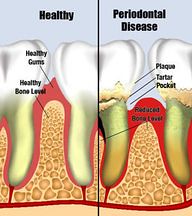 Periodontal gum disease is the number one leading cause of tooth loss in adults in America, but there are preventative measures people can take to keep their gum disease from progressing to the point where they have to lose their teeth. One of the most effective ways to treat gum disease is by catching it during its early stages and applying the appropriate antibiotic treatments to help kill the bacteria that causes gum disease before it continues to spread. One of the antibiotics that’s used to treat periodontal gum disease in Arestin.
Periodontal gum disease is the number one leading cause of tooth loss in adults in America, but there are preventative measures people can take to keep their gum disease from progressing to the point where they have to lose their teeth. One of the most effective ways to treat gum disease is by catching it during its early stages and applying the appropriate antibiotic treatments to help kill the bacteria that causes gum disease before it continues to spread. One of the antibiotics that’s used to treat periodontal gum disease in Arestin.
What is Arestin?
Arestin is an antibiotic treatment that kills the bacteria that causes gum disease right at its source. It’s essentially a powder substance that’s composed of more than 100,000 tiny microspheres that release antibiotics over time. Arestin is commonly recommended along with scaling and root planning. During SRP, dentists clean the plaque and tartar from patients’ teeth and roots, and while SRP is an effective treatment, it doesn’t always remove all the bacteria below the gum line that can produce the toxins that lead to periodontal gum disease. As the microspheres of Arestin are released, the antibiotics fight and kill any bacteria that’s left in the gums after the SRP procedure.
The Arestin Procedure
Arestin is locally administered and is a relatively quick and painless procedure. Dentist administer Arestin to patients by adding the formula to the pocket between patients’ gum and teeth. Once administered, the antibiotics begin to work right away and then continue to work even after patients leave the dental chair. The Arestin dissolves on its own, so there’s no need for any follow-up appointments for removal.
Is It Effective and Safe?
 Although patients can take antibiotic pills instead of utilizing Arestin, Arestin is FDA approved, and it provides patients with the antibiotics they need right at the source of where they need them. Antibiotic pills take time to circulate throughout the body’s system and can’t give patients the level of antibiotic concentration in their gums that Arestin can.
Although patients can take antibiotic pills instead of utilizing Arestin, Arestin is FDA approved, and it provides patients with the antibiotics they need right at the source of where they need them. Antibiotic pills take time to circulate throughout the body’s system and can’t give patients the level of antibiotic concentration in their gums that Arestin can.
After Getting Arestin Treatment
Although Arestin doesn’t require any surgical procedure or downtime, there are a few tips patients should keep in mind after getting Arestin placed within their gums to keep them healthy and ensure the Arestin performs to the best of its ability. First of all, they should avoid touching the area of their gums that were treated with Arestin since they’re likely to be sensitive. Additionally, they should wait 10 days before uses floss, toothpicks and other devices that are designed to clean between the teeth. Finally, they should avoid eating any hard, crunchy or sticky foods for at least a week after treatment.
References:
Van Dyke TE, Offenbacher S, Braswell L, Lessem J.. “Enhancing the value of scaling and root-planing: Arestin clinical trial results.” Retrieved on October 9, 2015, from http://www.ncbi.nlm.nih.gov/pubmed/12670085/.
The United States National Library of Medicine National Institutes of Health
8600 Rockville Pike,
Bethesda MD, 20894 USA
1-888-FIND-NLM
http://www.ncbi.nlm.nih.gov
Images:
https://farm6.staticflickr.com/5311/14323570054_c9f08c38bd_m.jpg
http://www.arestin.com/images/periodontal-gum-disease-treatment.jpg